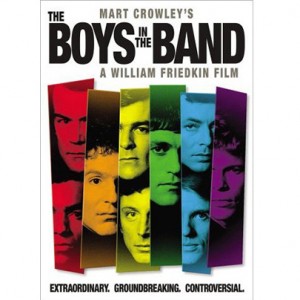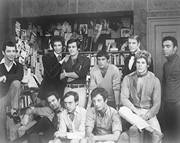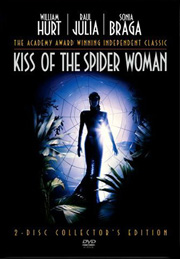Two Classics
‘The Boys in the Band’ and ‘Kiss of the Spider Woman.’
By John W. Stiles
 I was warned about this film. It was released almost 40 years ago, 1970 to be exact. Hmm, 1970—The Beatles released “Let It Be,” Simon and Garfunkel gave us “A Bridge Over Troubled Waters,” Diana Ross claimed “Ain’t No Mountain High Enough,” and The Kinks let us in on Lola’s secret. Hollywood gave us Patton, Love Story, Five Easy Pieces, M*A*S*H, Women in Love, and Woodstock. Fellini released Satyricon just to remind us that movies were made outside of California. In the world of print Dee Brown appraised us of our treatment of Native Americans in Bury My Heart at Wounded Knee, Germaine Greer took us inside the besieged female psyche in The Female Eunuch, Julia Child used liberal doses of wine in Mastering the Art of French Cooking, Charles Reich explained the counter-culture in The Greening of America, and Alvin Toffler warned us things were moving way too fast in Future Shock.
I was warned about this film. It was released almost 40 years ago, 1970 to be exact. Hmm, 1970—The Beatles released “Let It Be,” Simon and Garfunkel gave us “A Bridge Over Troubled Waters,” Diana Ross claimed “Ain’t No Mountain High Enough,” and The Kinks let us in on Lola’s secret. Hollywood gave us Patton, Love Story, Five Easy Pieces, M*A*S*H, Women in Love, and Woodstock. Fellini released Satyricon just to remind us that movies were made outside of California. In the world of print Dee Brown appraised us of our treatment of Native Americans in Bury My Heart at Wounded Knee, Germaine Greer took us inside the besieged female psyche in The Female Eunuch, Julia Child used liberal doses of wine in Mastering the Art of French Cooking, Charles Reich explained the counter-culture in The Greening of America, and Alvin Toffler warned us things were moving way too fast in Future Shock.
Isn’t it odd that in the same year mainstream media strove to catch up with the cultural revolution of the 1960s, an obscure off-off Broadway play about six gay men struggled to be heard. We were ready to hear women hated men for making them hate themselves, ready to accept our genocidal treatment of our country’s real ancestors, we were still coming to grips with the My-Lai and Kent State massacres, but first-time playwright Mart Crowley was told he was crazy to think anyone would produce a play about gay men in New York City. Finally able to get Edward Albee to give a look (his play Who’s Afraid of Virginia Woolf had made it all the way to the big screen four years earlier), The Boys in the Band was “workshopped” off-off-Broadway. Laurence Luckinbill (the bisexual Hank) knew they had a hit when only a week into production he saw several hundred gay men lined up for the less than 100 seats in their tiny workshop theater. It played a year to sold-out Broadway audiences.
Author Crowley insisted the original Broadway cast reprise their roles in the film. Dominick Dunne agreed to co-produce and the ever ambitious William Friedkin, soon to be famous for the yet unrealized The French Connection and The Exorcist, signed on to direct. The works of Harold Pinter and David Mamet are immediately recognizable for their scintillating dialogue, which is fast and smart, but has nothing on Mart Crowley’s brilliant work, The Boys in the Band. The only thing dated about this movie is the vibrant colors of the costume and set. We’re a bit more muted these days. A shame. Available November 11 from CBS Home Entertainment and Paramount Home Entertainment www.paramount.com/paramount.php.

Argentine director Hector Babenco spends two years begging his fellow countryman and author Manuel Puig to sell him the rights to his cult novel, Beijo da Mulher Aranha. Puig, wanting an international production and not Babenco’s planned Brazilian feature, won’t budge until he learns Burt Lancaster, fresh off his “comeback” in 1980’s Atlantic City, wants in. Lancaster has no patience for Leonard Schrader’s glacial pace in penning the screenplay and begins his own version. When Lancaster delivers his screenplay, Puig and Babenco are in despair. The Hollywood icon has rewritten Beijo and cast himself as the central figure.
The book was supposed to be about a struggle between two equals from entirely different political and social worlds suddenly confined together in a backwater prison cell. One, a straight Marxist revolutionary, the other an utterly apolitical aging gay queen. Their struggle with their own prejudices and preconceived notions set against a backdrop of degradation and intrigue has become a gay soap opera starring Burt Lancaster.
 Beijo da Mulher Aranha is headed back to regional cultdom when a hippie Santa Fe lawyer, a movie junkie from Warhol’s Factory and his old Factory buddy, a party girl by the nom de plume Baby Jane, decide to sink a million dollars American into a Brazilian film that no American studio will touch. William Hurt wants the role Lancaster lost, Raul Julia is signed on as the revolutionary, and Sonia Braga just happens to be dying for a small role so she can hang with the crew. The stars who were once swirling about a black hole suddenly align, and filming begins in Sao Paulo on Kiss of the Spider Woman.
Beijo da Mulher Aranha is headed back to regional cultdom when a hippie Santa Fe lawyer, a movie junkie from Warhol’s Factory and his old Factory buddy, a party girl by the nom de plume Baby Jane, decide to sink a million dollars American into a Brazilian film that no American studio will touch. William Hurt wants the role Lancaster lost, Raul Julia is signed on as the revolutionary, and Sonia Braga just happens to be dying for a small role so she can hang with the crew. The stars who were once swirling about a black hole suddenly align, and filming begins in Sao Paulo on Kiss of the Spider Woman.
Several inspired creative souls come together to realize a work of real significance. Hurt and Julia agree to work for scale, Schrader delivers a brilliant screenplay, director Babenco gets an old friend and choreographer to help Hurt uncover his feminine side. Sonia Braga has a ball, and Hurt and Julia spend endless hours working out their characters, unconstricted by studio demands. Hurt tells us of one Sunday Julia and he show up on the unconstructed set to work on a particular scene. They’re at it for hours before they realize the crew, not wanting to interfere, put down their hammers and is watching in rapt tearful silence as the two stars rehearse and rehearse.
Everyone associated with this project is in it for all the right reasons. It’s independent film at its most genuine. The result is an original work of unsurpassed strength and intensity as fresh and moving as any film of the past 25 years.
From City Lights Home Entertainment (citylightsmedia.com).
John W. Stiles (johnwstiles.com) writes regularly for OutSmart magazine.










